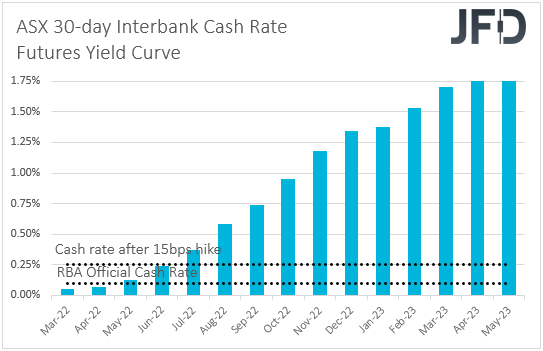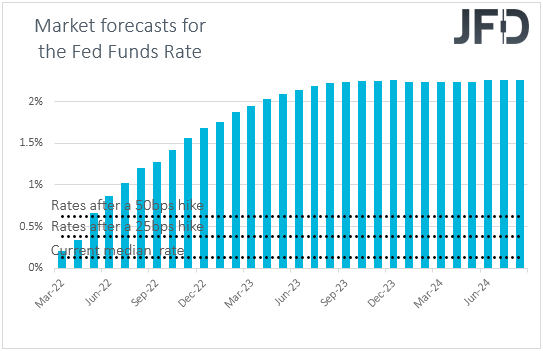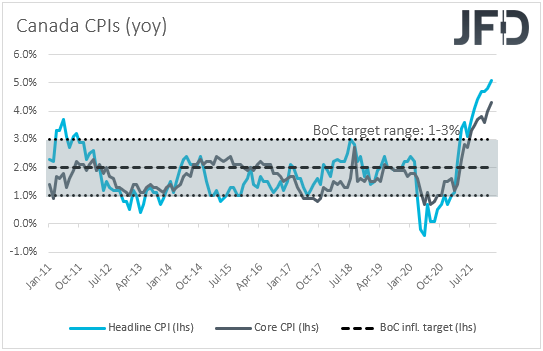We enter another week with the globe keeping its gaze locked on the conflict between Russia and Ukraine. However, market participants will also pay extra attention to the FOMC and BoE monetary policy decisions this week.
While both Banks widely anticipate rate hikes, investors will be eager to get updated information regarding their plans. Canada’s CPIs for February and Australia’s employment report for the same month are also due to be released.
There are no major data releases or events scheduled on the economic agenda on Monday. However, that doesn’t mean that a quiet trading day is guaranteed. For another week, investors will be biting their nails on how the crisis between Russia and Ukraine will unfold.
The latest updates suggest that both nations are willing to return to the negotiating table, but once again, this is far from suggesting that common ground could be found soon. Remember, we had talks last week, but they quickly fell apart. The conflict continues, and thus, with regards to the broader market sentiment, we maintain the view that the risks remain tilted to the downside.
On Tuesday, during the Asian session, we get the minutes from the latest RBA meeting. At that meeting, the Bank kept its policy tools untouched as expected. At the same time, in the accompanying statement, officials maintained their commitment to keeping supportive monetary conditions, repeating that they will not increase rates until actual inflation is sustainably within the 2-3% target range.
They also added that “the war in Ukraine is a major source of uncertainty,” leaving no room for participants to accelerate their tightening expectations, at least at the time.
However, fears of accelerating inflation around the globe allowed bets over multiple hikes this year to stay well on the table. According to the ASX interbank cash rate futures yield curve, investors expect the RBA to hike to 0.25% around June while seeing the OCR exceeding 1.25% by the end of the year.
Therefore, with all that in mind, we will dig into the minutes for clues and hints as to when policymakers are planning to hit the hike button and how many more liftoffs we could see before the end of the year. Anything pointing to a cautious approach may bring the Aussie under some selling interest. Still, we expect Thursday’s employment report to prove a bigger market mover, as it will be a piece of more updated information, which could shape expectations much better.
From China, we have the industrial production, retail sales, and fixed asset investment, all for the month of February. Industrial production is expected to have slowed somewhat, to +4.0% YoY from +4.3%, while retail sales are forecast to have accelerated to +3.0% YoY from +1.7%. The fixed asset investment rate is seen ticking up to +5.0% YoY from +4.9%.
During the early European session, we got the UK employment report for January, while a few hours later, Germany’s ZEW survey for March and Eurozone’s industrial production for January are due to be released. With regards to the UK report, the unemployment rate is expected to have ticked down to 4.0% from 4.1%, while the employment change is expected to show that the economy lost 65k jobs after losing 38k in December.
Average weekly earnings including bonuses are forecast to have accelerated, while the excluding bonuses rate is forecast to have held steady. Now, as far as the German survey is concerned, both the current conditions and expectations indices are forecast to have declined notably this month, but with the war in Ukraine and its consequences to the European economy, that will not come as a surprise.
In any case, we still see the path of least resistance for the euro as being to the downside. Eurozone’s industrial production is forecast to have slowed to +0.2% MoM in January, after expanding 1.2% in December. On Wednesday, the main item on the agenda is the FOMC interest rate decision.
Fed Chair Jerome Powell said that he would support a 25 bps hike at this gathering, and such a move is fully priced. Thus, in our view, a quarter-point hike by itself is unlikely to prove a significant market mover. We believe that investors will quickly turn their attention to the accompanying statement, the updated economic projections, and especially the new “dot plot.”
Remember that when testifying, Powell also said that he is ready to use larger or more frequent rate hikes if inflation doesn’t slow, with last week’s CPI data revealing further acceleration in both headline and underlying inflation. With market participants now pricing in around 6.5 quarter-point hikes by the end of the year, it will be interesting to see how many hikes will the dot plot predict.
Anything less than what the market currently suggests could disappoint and perhaps result in a setback in the dollar, while equities are likely to rebound. But, in line with our broader view, we will treat such a bounce as a corrective phase. To get confident in a long-lasting recovery in equities, we would like to see a resolution in the conflict between Russia and Ukraine.
For the US dollar to continue marching higher, we would like to see officials matching or exceeding market expectations, something we see as a problematic case if we consider that the December dot plot pointed only to three rate increases in 2022.
As of Wednesday’s data, Canada’s CPIs for February are also on the agenda, with the headline rate expected to have risen further, to +5.5% from +5.1%. No forecast is currently available for the core rate.
At their latest gathering, BoC policymakers hiked by 25 bps, as it was widely anticipated, and, while they acknowledged the uncertainty surrounding Russia’s invasion in Ukraine, they added that rising commodity prices would fuel further inflation and that growth for the first quarter of 2022 now looks more solid than previously projected.
This may have encouraged Loonie traders to add to their bets with regards to future rate hikes by this Bank, and accelerating inflation is likely to allow them to add some more, and thereby buy more Loonies.
As for the rest of Wednesday’s events, during the Asian session, we get New Zealand’s current account balance for Q4 and Japan’s trade data for February. Later, during the US session, ahead of the FOMC decision, we have the US retail sales for February. Both headline and core sales are forecast to have slowed, to +0.4% MoM and +1.0% MoM, from +4.8% and 3.3% respectively.
On Thursday, the central bank torch will be passed to the BoE. When they last met, officials of this Bank voted 5-4 for a hike by 25 bps, with the four dissenters calling for a 50 bps increase. Since then, we’ve highlighted that only one member needed to be convinced for that to happen at the upcoming gathering. Indeed, the accelerating CPIs for January added to speculation on that front.
However, this was the case around a week before Russia invaded Ukraine, with the events unfolding since then raising concerns over the global economic performance, and especially in Europe, something evident by the tumbles in the euro and the pound.

Thus, we don’t believe that the BoE will now stay willing to hike by 50bps this week with all that in mind. According to the UK OIS (Overnight Index Swaps) forward curve, market participants believe a quarter-point hike will be delivered. Therefore, if this is the case, we will be eager to see the Bank’s assessment of the war in Ukraine and how this is affecting their future course of action.
Similarly, investors expect the BoE to deliver around six quarter-point hikes with the Fed by the end of the year. It will be interesting to see whether officials’ views and language match those expectations.
As for Thursday’s data, during the Asian session, Australia releases its employment report for February. The unemployment rate is expected to have ticked down to 4.1% from 4.2%, while the net change in employment is forecast to show that the economy has added 37k jobs after adding 12.9k in January. In our view, these numbers point to a decent report, which may allow market participants to keep their RBA hike bets elevated and thereby support the Aussie at the time of the release.
Later in the day, Eurozone’s final CPIs for February are coming out. As is usually the case, they are expected to confirm their preliminary estimates, while from the US, we have the housing starts for the same month, which are forecast to have increased somewhat.
Finally, on Friday, during the Asian session, we have another major central bank deciding on monetary policy, and this is the BoJ. However, with Japanese inflation still running well behind the rest of the world, we don’t expect any material changes. Once again, any reaction to the yen is likely to be insignificant. Japan’s CPIs for February are also coming out, with the core rate expected to inch up to +0.6% YoY, confirming the aforementioned statement.
From New Zealand, we get the GDP data for Q4, with the QoQ rate expected to have rebounded to +3.4% from -4.7%, something that will take the YoY one up to +3.3% from -0.3%. At its latest gathering, the RBNZ lifted interest rates by another 25 bps, to 1%, and steepened its rate-path projections.
So, with that in mind, a rebound in economic activity during the last quarter of 2021 may add credence to officials’ views and perhaps encourage Kiwi traders to add to their long positions. Later in the day, Canada’s retail sales for January are due to be released.
Headline sales are forecast to have rebounded 2.4% MoM after sliding 1.8% in December, but core sales are anticipated to have continued sliding, albeit at a slower pace. Specifically, the forecast points to a 2.0% MoM slide after a 2.5% fall the month before.
